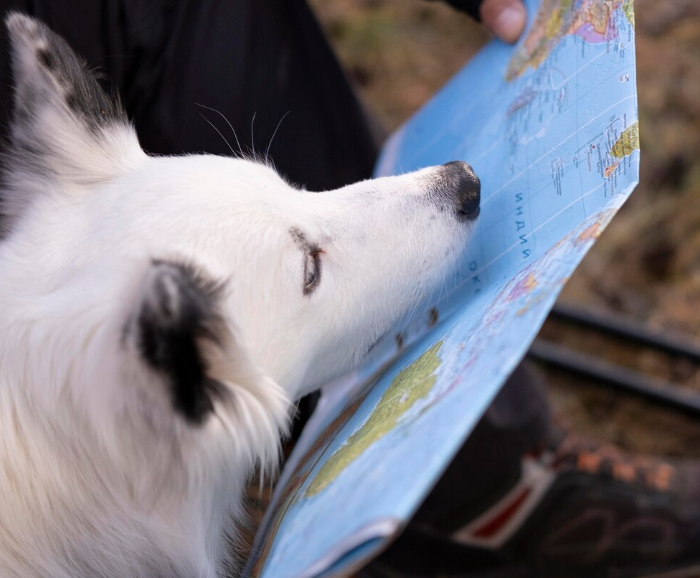
To function as a society, we need rules that are typically implemented through various laws and documents. Proper documentation is absolutely essential for an individual or their activity to be considered legitimate and to ensure that their rights, responsibilities, and obligations are clearly defined and enforceable.
The need for documentation has expanded beyond humans and now applies to our beloved pets as well, especially if we plan to travel with them. Passports, certificates, microchip numbers, vaccination records—it’s a long list of documents we need to prepare for our dogs and cats, whether for travel or simply to ensure they are recognized as 'legitimate' under local laws.
When it comes to service dogs, things can quickly become even more complicated. The lack of unified service dog laws worldwide, lingering myths and misconceptions, attempts to exploit the system, and a general lack of awareness often create challenges for service dog teams globally.
Service dog documentation plays a key role in the complex dynamic between service dog teams and the public. Let’s delve into the topic and explore what a service dog pass actually is, how to obtain one, and whether you should consider getting it.
What Do We Mean by Service Dog Pass?
A service dog pass typically refers to documents (identifiers) that confirm the status of a dog as a trained service animal for an individual with a disability. While the term “pass” might sound official or government-issued, in most countries it is not a legal requirement, but rather a practical aid used to ease public interactions.
This documentation can take several forms, including:
- A certificate as proof of training, issued by a training school or organization, often including the handler’s name, the dog’s name, and additional details such as their breed, age, and microchip number, and specific tasks the dog has been trained to perform as a service animal.
- An ID card, often including the handler’s name, the dog’s name, a photo, a unique number that can be easily verified in a database, and a statement confirming the dog’s status as a service animal.
- A medical letter from a licensed healthcare provider confirming the individual’s disability and the need for a service animal can be useful in various situations. For example, it may help when arranging housing accommodations for a service dog in a property with a ‘no pets’ policy, especially if the dog performs tasks that aren’t immediately visible.
- A vest or tag that identifies the dog as a service animal, which can help notify the public and business owners that the dog is on duty and should not be distracted.
- Travel-specific paperwork, such as airline disability forms, veterinary health records, or behavioral declarations required for international or domestic air travel.
These documents are especially helpful when visiting public spaces, boarding transportation, or arranging housing, where questions about your dog’s role as a service animal may come up. For example, airline representatives, hotel managers, or shop owners might ask for confirmation that a dog is a service animal. While they cannot legally demand a Service Dog ID in many countries and regions, presenting documentation as proof of the dog’s status as a service dog can prevent misunderstandings and reduce confrontation.
We’d like to point out that it’s ultimately the dog’s training and behavior that prove they are a trained service animal and not just the paperwork. Proper documentation only facilitates communication with business owners and the public in general, and ensures a more positive experience.

Service Dog Pass and Airlines
You may wonder if there is a difference between the term ‘service dog pass’ in the context of documentation for identification purposes and in terms of air travel.
Airlines like American Airlines have explained that the process of requesting travel with a service dog, as a two-step procedure:
1. Fill out and submit a DOT form;
2. Once the form has been approved and the airline provides a service dog ID (SVAN ID). Service dog handlers can add this ID when booking future travel with their animal and be approved without resubmitting forms. The SVAN ID expires after 1 year from the date of signature or when the animal’s vaccination expires, whichever is first.
However, until November 2024, the airline also offered an alternative to the SVAN ID, called a Service Dog Pass™.
“Service Dog Pass™
Handlers with a Service Dog Pass ID (SDP ID) can enjoy a more seamless travel experience thanks to our partnership with K9s For Warriors and Service Dog Pass. You can add an SDP ID instead of an American-issued Service Animal ID (SVAN ID) when booking travel with us and be approved without submitting forms."
Service Dog Pass™ (SDP) was a voluntary program that accepted service dog teams who had graduated from organizations accredited or approved by Assistance Dogs International (ADI), the Association of Service Dog Providers for Military Veterans (ASDPMV), the International Association of Canine Professionals (IACP*), and/or the International Guide Dog Federation (IGDF) during its initial phase.
For IACP-affiliated teams, participation required having taken the Public Access Test (PAT) with an Authorized Administrator.
As the program evolved, it also welcomed service dogs who had been self-trained or trained by organizations or businesses not affiliated with the above-mentioned accrediting bodies. These teams could complete the SDP assessment, and upon passing, receive a valid SDP credential.
However, this service was discontinued at the end of 2024.

Who Qualifies for a Service Dog and Supporting Documentation?
Before applying for any kind of service dog ID, or certificate, whether through a training organization, a voluntary registry, or for travel/housing purposes, it’s essential to understand the qualifications. Service dogs are not pets, nor are they emotional support animals. They are legally recognized working animals trained to assist individuals with disabilities. They have the status of medical equipment and not viewed as pets. That said, pet policies of housing providers, business owners or airlines don’t apply to them.
Eligibility
To be eligible for a service dog and any form of supporting documentation, an individual must have a recognized disability. We’ll make a quick note here to clarify the term ‘disability’ under the laws in several countries.
According to the Guide to Disability Rights Laws in the US:
“An individual with a disability is defined by the ADA as a person who has a physical or mental impairment that substantially limits one or more major life activities, a person who has a history or record of such an impairment, or a person who is perceived by others as having such an impairment. “
According to the Equality Act 2010 in the UK:
“You’re disabled under the Equality Act 2010 if you have a physical or mental impairment that has a ‘substantial’ and ‘long-term’ negative effect on your ability to do normal daily activities.
According to the Federal Disability Reference Guide in Canada:
Disability is a complex phenomenon, reflecting an interaction between features of a person's body and mind and features of the society in which they live. A disability can occur at any time in a person's life; some people are born with a disability, while others develop a disability later in life. It can be permanent, temporary or episodic. Disability can steadily worsen, remain the same, or improve. It can be very mild to very severe. It can be the cause, as well as the result, of disease, illness, injury, or substance abuse.
Because of its complexity, there is no single, harmonized “operational” definition of disability across federal programs.”
According to the Australian Public Service Commission:
“The definition of ‘disability’ used for employment-related purposes (other than discrimination) in the APS is based on the Australian Bureau of Statistics’ Survey of Disability, Ageing and Carers.2
Persons are considered to have a disability if they have a limitation, restriction or impairment, which has lasted, or is likely to last, for at least six months and restricts everyday activities3.”
Individuals don’t always need to “look” disabled to qualify. Many legitimate service dog handlers have invisible or non-obvious disabilities.
Task Training
To be recognized as a service dog, a dog must be individually trained to perform specific, disability-related tasks. These tasks must directly mitigate the effects of a person’s health condition. Examples include:
- Alerting to oncoming medical episodes, such as changes in the blood sugar levels, cardiac issues, seizures, etc.
- Interrupting panic attacks or self-harm behaviors.
- Providing deep pressure therapy (DPT) and other types of tactile stimulation to help the individual calm down and get back to reality, a process also known as ‘grounding’.
- Guiding individuals with visual impairments.
- Assisting with balance or stability.
- Reminding to take medication.
In many countries, current legislation states that a dog must be trained to perform specific tasks and that comfort and companionship alone are no longer sufficient for a dog to get a service animal status.

Do Service Dogs Undergo Task Training Only?
No, training a service dog and becoming eligible for service dog training or identification gear is a complex process that includes three essential components:
1. Basic Obedience Training;
2. Task-based Training;
3. Public Access Manners.
Training always begins with the basics so that the dog learns impulse control, gets properly socialized and is taught to reliably respond to obedience cues, such as ‘sit’, ‘stay’, and ‘come’. Focus training is another essential step in the basic obedience portion of the process, ensuring the dog can remain on their handler and not get distracted.
Task-based training begins only after the dog has had a solid foundation and responsiveness to obedience cues. As explained, the specific tasks a service dog can be trained to perform vary from person to person and sometimes, they are not immediately apparent. The public should interact with service dog teams respectfully without jumping to conclusions only based on how things look. There are many individuals with hidden disabilities who greatly rely on their service animals to regain their independence and confidence.
Public access training is absolutely mandatory for service animals, as it helps ensure the dog can reliably perform tasks and follow commands in a wide range of environments. Service dogs may be excluded from public spaces if they misbehave or cause disruptions, which is why good manners in public are so important. Calmly meeting new animals or people and being composed in busy environments helps ensure the handler gets the so much needed support.
That said, the public should also learn not to interact with service dogs or service dogs in training unless the handler specifically allows that. Many service dogs wear vests, harnesses, or patches that say “Do Not Pet” or “Service Dog at Work,” but not all do, and they aren’t required to in many countries. It's important for the public to understand that distracting a service dog, even with the best intentions, can interfere with the dog’s ability to assist its handler safely and effectively.
To finish today’s article, we’d like to highlight the importance of being aware of local service dog regulations, including rules about identification gear, documentation, and public access rights. Whether you’re a handler, a business owner, or a bystander, knowing the laws and respecting boundaries helps create a safer and more inclusive environment for people who rely on service dogs every day.
If you're unsure about a service dog’s access rights or your responsibilities under the law, take the time to research regulations in your country or state. Respect, awareness, and education go a long way in supporting people with disabilities and their amazing paw companions who help them navigate the world!












